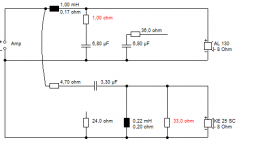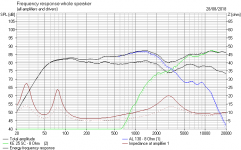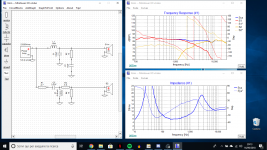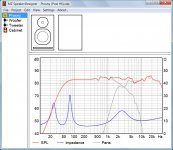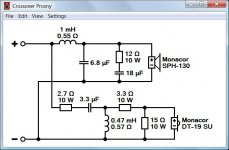Hi everyone,
some years ago i built a pair of bookshelf speakers following a relatively famous project here in my country: 6l, sealed, with Monacor components (DT-19SU and SPH-130). Now, since I'm already in the process of building a small boombox, I also wanted to rework these speakers to make them sound better (read: to make them have some bass).
This would be my first time designing speakers on my own, so feel free to point out any mistakes I might have made.
Let's start with the crossover:
This was its original crossover, for comparison with mine
This is my crossover (I don't know if you can see the values, I can write them down if needed).
The frequency response in mine is flatter overall, but the previous designer must have had his reasons, since he used to sell his designs and I don't
I also haven't done anything regarding baffle step loss, since these speakers are probably going to be positioned very close to the back wall. Is it a good idea?
Do you guys think I'm missing something here? Because otherwise I think I'm going to try my own design. I'm still learning after all.
Concerning box tuning: I wanted to go vented to squeeze out some bass from these drivers. Now I get an f3 of about 50hz with 10 liters tuned to 50hz. The problem is, whatever I do, I keep exceeding xmax from 35hz down with just one watt. I know it is normal for a vented design to show this behaviour, but in this case I would not be able to apply a digital high pass filter, so I don't know if I should worry about it or not
Thanks for reading all of this, and I wish everyone a nice day.
some years ago i built a pair of bookshelf speakers following a relatively famous project here in my country: 6l, sealed, with Monacor components (DT-19SU and SPH-130). Now, since I'm already in the process of building a small boombox, I also wanted to rework these speakers to make them sound better (read: to make them have some bass).
This would be my first time designing speakers on my own, so feel free to point out any mistakes I might have made.
Let's start with the crossover:
This was its original crossover, for comparison with mine
An externally hosted image should be here but it was not working when we last tested it.
This is my crossover (I don't know if you can see the values, I can write them down if needed).
An externally hosted image should be here but it was not working when we last tested it.
The frequency response in mine is flatter overall, but the previous designer must have had his reasons, since he used to sell his designs and I don't
I also haven't done anything regarding baffle step loss, since these speakers are probably going to be positioned very close to the back wall. Is it a good idea?
Do you guys think I'm missing something here? Because otherwise I think I'm going to try my own design. I'm still learning after all.
Concerning box tuning: I wanted to go vented to squeeze out some bass from these drivers. Now I get an f3 of about 50hz with 10 liters tuned to 50hz. The problem is, whatever I do, I keep exceeding xmax from 35hz down with just one watt. I know it is normal for a vented design to show this behaviour, but in this case I would not be able to apply a digital high pass filter, so I don't know if I should worry about it or not
Thanks for reading all of this, and I wish everyone a nice day.
You can attach images to the forum direct after 5 posts, I believe. External links tend to die after a while.
The original design you show must be wrong. That 0.42mH must be shunted across the tweeter, not in series with it. The top will roll of very badly as it is.
I can't actually read the bass RC, is it 6.8uF and 16R? Your design looks OK, apart from the 24R resistor in front of the tweeter filter. It should be after the coil. It's just burning bass power as it is. You should get more bass there, for sure.
You don't have much XMax at +/- 2mm, which maybe why Monacor say this 90dB, 22l Vas, Qts 0.30 reflex driver is a good midrange.
MONACOR - Products - SPH-130
Just won't go loud, I suppose.
The original design you show must be wrong. That 0.42mH must be shunted across the tweeter, not in series with it. The top will roll of very badly as it is.
I can't actually read the bass RC, is it 6.8uF and 16R? Your design looks OK, apart from the 24R resistor in front of the tweeter filter. It should be after the coil. It's just burning bass power as it is. You should get more bass there, for sure.
You don't have much XMax at +/- 2mm, which maybe why Monacor say this 90dB, 22l Vas, Qts 0.30 reflex driver is a good midrange.
MONACOR - Products - SPH-130
Just won't go loud, I suppose.
Last edited:
First of all, thanks for helping me out.
About the original crossover you're right, I forgot to mention that there is a point of connection where the wire after the 3.9 ohm resistor crosses the coil: the first time I've tried a simulation it looked very strange, so I figured that should be how it is supposed to be wired.
About my crossover, I will post the values so you will have no problems reading them:
on the woofer, the capacitors are both 6.8uF, the coil is 1mH and the resistor was 36ohm, but I've just changed it to 30 because the curve looks a bit better;
on the tweeter, the capacitor is 3.3uF, the coil is 0.22mH and the resistors are 4.7 and 24ohms. About this last one resistor, do you mean I should put it in parallel to the driver after the coil (just tried it and the response looks weird, so I think that's not what you meant)?. And also, how is it burning bass power when it's on the tweeter? (legit question, I know close to nothing about these things and am here to learn something)
You're right about the driver, knowing what I know now I wouldn't have bought it. But at the time I was much younger and just chose the most appealing project I had found. It won't have to go much louder than evening TV levels, so I guess it will be fine.
About the original crossover you're right, I forgot to mention that there is a point of connection where the wire after the 3.9 ohm resistor crosses the coil: the first time I've tried a simulation it looked very strange, so I figured that should be how it is supposed to be wired.
About my crossover, I will post the values so you will have no problems reading them:
on the woofer, the capacitors are both 6.8uF, the coil is 1mH and the resistor was 36ohm, but I've just changed it to 30 because the curve looks a bit better;
on the tweeter, the capacitor is 3.3uF, the coil is 0.22mH and the resistors are 4.7 and 24ohms. About this last one resistor, do you mean I should put it in parallel to the driver after the coil (just tried it and the response looks weird, so I think that's not what you meant)?. And also, how is it burning bass power when it's on the tweeter? (legit question, I know close to nothing about these things and am here to learn something)
You're right about the driver, knowing what I know now I wouldn't have bought it. But at the time I was much younger and just chose the most appealing project I had found. It won't have to go much louder than evening TV levels, so I guess it will be fine.
I don't think it's a bad driver at all. Just won't shake the room with bass. This sort of thing is a bedroom speaker anyway. Not meant to go loud.
Below is a simplified circuit for you that does much the same thing. Don't worry about the frequency response beyond it being unchanged. What does change is the impedance, because the resistor is in the right place.
I don't have your modelling, so you must trust yourself on that. You might try a third order filter too. A 10uF after the 3.3uF. Usually works OK.
Below is a simplified circuit for you that does much the same thing. Don't worry about the frequency response beyond it being unchanged. What does change is the impedance, because the resistor is in the right place.
I don't have your modelling, so you must trust yourself on that. You might try a third order filter too. A 10uF after the 3.3uF. Usually works OK.
Attachments
Thanks again.
I've tried to simulate your XO and, in fact, with your design I gain something like 1db in all the bass region (and I have no idea why, since you have only changed stuff on the tweeter ). The 24 ohm resistor of the Lpad shouldn't be connected as your scheme says, right?
). The 24 ohm resistor of the Lpad shouldn't be connected as your scheme says, right?
So why doesn't the "traditional" Lpad work here? what am I missing?
And also, why shouldn't I be aiming to a flat impedance across the frequency response? Is changing the driver's impedance outside of the XO point a bad idea?
I've tried to simulate your XO and, in fact, with your design I gain something like 1db in all the bass region (and I have no idea why, since you have only changed stuff on the tweeter
So why doesn't the "traditional" Lpad work here? what am I missing?
And also, why shouldn't I be aiming to a flat impedance across the frequency response? Is changing the driver's impedance outside of the XO point a bad idea?
A couple of weeks later, I'm still working on the theoretical part of the rebuild of these two speakers. I wanted to try to build a slot port instead of the standard cylindrical port.
I've had a really hard time figuring out the correct internal dimensions for the tuning WinISD was suggesting, but I think I've eventually come to an end (I have obviously already calculated the rough volume taken by the drivers and by the port). The box should be 10 liters with a tuning of 45.3 Hz, giving me an f3 of about 50 Hz.
I've also re-done the crossover, to lower the XO point to the recommended 3000 Hz and to bring up a little bit the 700 Hz region; I've attached the screenshot.
So... here are the questions (get ready ):
):
1. is the slot port a good idea? I personally like it because it makes it easier for me to build a shorter box and it gives me very low port air velocity;
2. what is the best material to build this kind of box? Last time I've used MDF, but I would avoid using it this time if possible. What do you guys think about poplar plywood? I've read good things on another thread, but it was only one opinion, and I would like to hear more;
3. last one I promise. What do you think about my new XO design? Am I good to go?
Thanks as always for your help and patience
I've had a really hard time figuring out the correct internal dimensions for the tuning WinISD was suggesting, but I think I've eventually come to an end (I have obviously already calculated the rough volume taken by the drivers and by the port). The box should be 10 liters with a tuning of 45.3 Hz, giving me an f3 of about 50 Hz.
I've also re-done the crossover, to lower the XO point to the recommended 3000 Hz and to bring up a little bit the 700 Hz region; I've attached the screenshot.
So... here are the questions (get ready
1. is the slot port a good idea? I personally like it because it makes it easier for me to build a shorter box and it gives me very low port air velocity;
2. what is the best material to build this kind of box? Last time I've used MDF, but I would avoid using it this time if possible. What do you guys think about poplar plywood? I've read good things on another thread, but it was only one opinion, and I would like to hear more;
3. last one I promise. What do you think about my new XO design? Am I good to go?
Thanks as always for your help and patience
Attachments
What do you think about my new XO design? Am I good to go?
As far as I can tell everything looks good, certainly better than the original.
No problems using plywood and a slot port. However, the port length is tricky to calculate because it is extended by an unknown amount from the nearby cabinet walls.
Attachments
Thanks for your reply.
Since I had also read that the effective port tuning would be a bit lower because of air friction, especially because my port would be only 2cm thick by 18cm wide, I have tuned it 5 Hz higher to compensate (I have no clue if it is even nearly close to enough, but I've seen that the response changes almost non-existently anyways, so I think I'm gonna be fine).
Another question I had was about the resistors. I'm ordering from a french e-shop, I don't know if I can write the full name in here, and there are a couple of choises in my budget: Dayton Audio 10W ceramic resistors, or Mundorf 5W or 10W non inductive resistors (which cost about 50cents less per unit); which one should I use? Are the mundorf ones okay for speakers too?
Since I had also read that the effective port tuning would be a bit lower because of air friction, especially because my port would be only 2cm thick by 18cm wide, I have tuned it 5 Hz higher to compensate (I have no clue if it is even nearly close to enough, but I've seen that the response changes almost non-existently anyways, so I think I'm gonna be fine).
Another question I had was about the resistors. I'm ordering from a french e-shop, I don't know if I can write the full name in here, and there are a couple of choises in my budget: Dayton Audio 10W ceramic resistors, or Mundorf 5W or 10W non inductive resistors (which cost about 50cents less per unit); which one should I use? Are the mundorf ones okay for speakers too?
I’m sorry for the repost, but I would like to be done with designing the speakers to get some things done as soon as possible.
Does anyone know the answers to my questions about the material that I would like to use (poplar) and the resistors (weirdly enough I haven’t found anything specific regarding these Mundorf MR5 that are on sale, and the (dis)advantages compared to ceramic resistors)?
Thanks to everyone for the help
Does anyone know the answers to my questions about the material that I would like to use (poplar) and the resistors (weirdly enough I haven’t found anything specific regarding these Mundorf MR5 that are on sale, and the (dis)advantages compared to ceramic resistors)?
Thanks to everyone for the help
I really dislike slot ports in the case someone wants to test various tuning. For test purposes a tube is way better, start long and shorten it until you'll find the tuning that works best. For a slot port you have to rebuild the whole cab.
Metal Oxide Resistors (MOX) are good for audio use, better than the ceramic ones, which are good enough in any case.
Poplar ply should be a good material for cabs construction. But IME it is hard to find the quality poplar ply needed for cabs construction! Also good MDF is hard to find (without soft core), so probably the best easily available material is birch ply. YMMV
Ralf
Metal Oxide Resistors (MOX) are good for audio use, better than the ceramic ones, which are good enough in any case.
Poplar ply should be a good material for cabs construction. But IME it is hard to find the quality poplar ply needed for cabs construction! Also good MDF is hard to find (without soft core), so probably the best easily available material is birch ply. YMMV
Ralf
Thank you very much. I think you've just changed my mind about the slot port, even though it's a shame because I really like the way it would have looked. Round port it is then.
About the material, I wanted to steer away from MDF because I didn't really like it the first time I've used it: I've found it very fragile, but I guess I can live with it if poplar plywood is not that much of an "upgrade". Birch plywood is not really an option, since I will have to get the wood cut from a famous French named bricolage center (you should know it, since according to your flag you should come from my same country) and it'd cost almost 3x what MDF would, while poplar would be something less than 2x. Guess I'll stick to MDF then, I would have to paint it anyway, so...
About the material, I wanted to steer away from MDF because I didn't really like it the first time I've used it: I've found it very fragile, but I guess I can live with it if poplar plywood is not that much of an "upgrade". Birch plywood is not really an option, since I will have to get the wood cut from a famous French named bricolage center (you should know it, since according to your flag you should come from my same country) and it'd cost almost 3x what MDF would, while poplar would be something less than 2x. Guess I'll stick to MDF then, I would have to paint it anyway, so...
MDF is the easiest material to cut and work with a router, as it doesn’t split like birch ply. OTOH the exposed cut is a pain to paint, as it absorbs more than the flat face. I had good results in this respect building cabs out of 16mm MDF and then cover them with 3mm MDF, so the exposed internal part is really minimal. Also beware of low cost/quality MDF where only the outer shell is hard while the internal part is soft.
I feel your problem in finding good material, as I had the same problem. A possible better material could be marine ply, but I haven’t used it yet.
Slot ports aren’t devil, they simply are really difficult to modify, so aren’t suited IMHO when you are testing a new box/driver. In this situation build test cabs out of the cheapest material you can find, and when you find the tuning that suits you best build the final cabs out of good material.
Ralf
I feel your problem in finding good material, as I had the same problem. A possible better material could be marine ply, but I haven’t used it yet.
Slot ports aren’t devil, they simply are really difficult to modify, so aren’t suited IMHO when you are testing a new box/driver. In this situation build test cabs out of the cheapest material you can find, and when you find the tuning that suits you best build the final cabs out of good material.
Ralf
- Status
- This old topic is closed. If you want to reopen this topic, contact a moderator using the "Report Post" button.
- Home
- Loudspeakers
- Multi-Way
- XO and box tuning for 2way Monacor build
